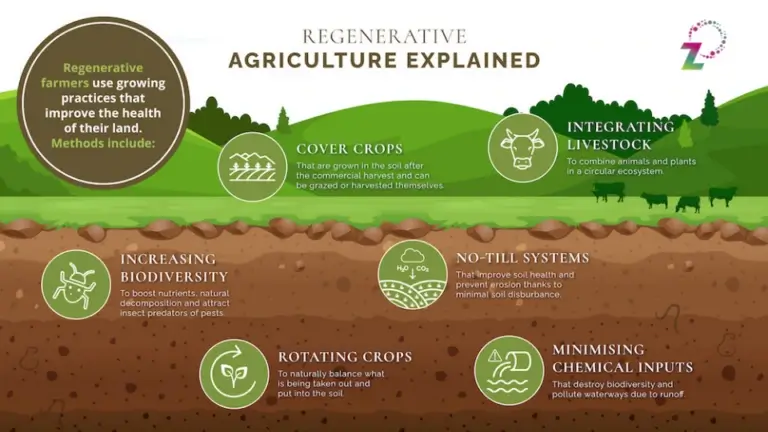In the face of climate change, declining soil fertility, and rising food insecurity, regenerative agriculture is emerging as a game-changing approach to restoring the health of our soils—and with it, the resilience of our farming systems.
Unlike conventional agriculture, which often depletes the soil through heavy tillage, chemical inputs, and monocropping, regenerative agriculture prioritizes soil regeneration, biodiversity, and natural cycles. It’s not just about sustainability—it’s about healing the land and making it better than it was before.
What Is Regenerative Agriculture?
At its core, regenerative agriculture is a holistic farming philosophy that aims to improve and restore ecosystem health. It integrates traditional knowledge with modern science, emphasizing:
- Minimal soil disturbance
- Permanent ground cover with crops or organic matter
- Diverse crop rotations
- Integration of livestock
- Composting and natural fertilizers
These practices work together to rebuild soil organic matter, increase microbial activity, enhance carbon sequestration, and ultimately lead to more productive and climate-resilient farms.
The Soil Health Connection
Healthy soil is living soil—teeming with bacteria, fungi, earthworms, and organic matter that form a thriving underground ecosystem. But decades of over-farming, erosion, and chemical overuse have stripped much of Africa’s arable land of this natural vitality.
Regenerative agriculture reverses this trend by:
- Boosting carbon in the soil, which improves water retention and structure
- Reducing erosion and nutrient runoff
- Encouraging root systems that feed soil organisms
- Eliminating dependency on synthetic fertilizers
As soil health improves, so does crop health. Studies show that regenerative farms often outperform conventional farms in terms of resilience, especially under drought or heat stress.
Real Impact on African Farms
Across the continent, forward-thinking farmers are beginning to adopt regenerative methods—with impressive results.
In Kenya, smallholder maize farmers integrating composting and cover crops have seen yields rise by up to 30%. In Zimbabwe, rotational grazing and silvopasture are bringing degraded rangelands back to life. And in South Africa, no-till techniques and legume intercropping are restoring fertility in previously depleted soils.
These results go beyond yields. Regenerative practices help cut input costs, reduce pests naturally, and build climate resilience—all while empowering local communities to manage their own land sustainably.

A Global Movement with Local Relevance
The regenerative agriculture movement is gaining global momentum, supported by food companies, NGOs, and climate activists. But for Africa, it’s more than a trend—it’s a necessity.
The continent faces unique challenges: rapid population growth, climate variability, and a high reliance on rainfed agriculture. Regenerative agriculture offers low-cost, nature-based solutions that align with Africa’s cultural heritage of land stewardship.
Yet, wider adoption requires more than farmer will—it demands:
- Education and training on regenerative techniques
- Access to markets that reward sustainable produce
- Policy support and investment from governments and development partners
The Road Ahead: Regeneration as a Strategy
As we look to the future of African agriculture, the question is not just how to produce more food, but how to do it in a way that restores the land, empowers farmers, and strengthens food security.
Regenerative agriculture, anchored in soil health, offers that path.

It turns the soil from a depleted resource into a living ally—one that can nourish future generations, capture carbon, and help Africa thrive in a changing climate.
“The nation that destroys its soil destroys itself.” – Franklin D. Roosevelt
Africa’s farmers are not just producers—they are stewards of the earth. By investing in regenerative agriculture, we restore not just soil, but hope.